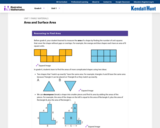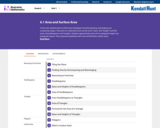
Family facing 6th Grade math unit focusing on area and surface area.
- Subject:
- Geometry
- Mathematics
- Material Type:
- Unit of Study
- Provider:
- Illustrative Mathematics
- Date Added:
- 11/17/2020

Family facing 6th Grade math unit focusing on area and surface area.

In this unit, students learn to find areas of polygons by decomposing, rearranging, and composing shapes. They learn to understand and use the terms “base” and “height,” and find areas of parallelograms and triangles. Students approximate areas of non-polygonal regions by polygonal regions. They represent polyhedra with nets and find their surface areas.

This task examines the ways in which the plane can be covered by regular polygons in a very strict arrangement called a regular tessellation. These tessellations are studied here using algebra, which enters the picture via the formula for the measure of the interior angles of a regular polygon (which should therefore be introduced or reviewed before beginning the task). The goal of the task is to use algebra in order to understand which tessellations of the plane with regular polygons are possible.

In this video tutorial lesson, determine the area of a parallelogram using triangles and rectangles then assess learning with a quiz. [3:34]

In this video, students will determine the area of a trapezoid and assess learning with a quiz. [4:24]

This video tutorial shares several examples of different types of triangles as they are used to determine the area of each triangle. Assessment checks understanding. [6:54]

Students apply what they know about area of other polygons to develop a formula for finding the area of a triangle.

Online drawing programs allow students to explore many possibilities with polygons!

Interacting with polygons and testing the definitions can be engaging, fun and build a powerful, individualized understanding.

Connecting the dots between Geometry and the Coordinate Grid.

You will enjoy this shape game. It tells you the name of a shape and all you have to do is click on the correct shape. If you get confused you can have another try.

This book is a "flexed" version of CK-12's Basic Geometry that aligns with College Access Geometry and contains embedded literacy supports. It covers the essentials of geometry for the high school student.

CK-12 Foundation's Geometry FlexBook is a clear presentation of the essentials of geometry for the high school student. Topics include: Proof, Congruent Triangles, Quadrilaterals, Similarity, Perimeter & Area, Volume, and Transformations.

In this video segment from Cyberchase, the CyberSquad measures Judge Trudy's land claim by using tarps, fence posts and a grid made with rope.

Use different size triangle to determine how to solve for the area in this video lesson. Take quiz to check understanding. [3:41]

This interactive diagram focuses on sorting polygons by common properties and then you select the correct label for each section of the Venn Diagram.

Demonstrates how to decide which quadrilaterals match a set of given properties. [2:28]
Khan Academy learning modules include a Community space where users can ask questions and seek help from community members. Educators should consult with their Technology administrators to determine the use of Khan Academy learning modules in their classroom. Please review materials from external sites before sharing with students.

Explains how to classify 2D shapes based on the properties of their sides and angles. [2:15]
Khan Academy learning modules include a Community space where users can ask questions and seek help from community members. Educators should consult with their Technology administrators to determine the use of Khan Academy learning modules in their classroom. Please review materials from external sites before sharing with students.

Demonstrates how to find what 2D shape matches a set of properties. [3:37]
Khan Academy learning modules include a Community space where users can ask questions and seek help from community members. Educators should consult with their Technology administrators to determine the use of Khan Academy learning modules in their classroom. Please review materials from external sites before sharing with students.

Discusses the different types of triangles and their angles. [6:00]
Khan Academy learning modules include a Community space where users can ask questions and seek help from community members. Educators should consult with their Technology administrators to determine the use of Khan Academy learning modules in their classroom. Please review materials from external sites before sharing with students.